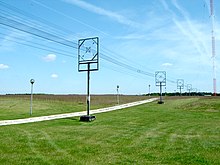Radio frequency power transmission

Radio frequency power transmission is the transmission of the output power of a transmitter to an antenna. When the antenna is not situated close to the transmitter, special transmission lines are required.[1]

The most common type of transmission line for this purpose is large-diameter coaxial cable. At high-power transmitters, cage lines are used. Cage lines are a kind of overhead line similar in construction to coaxial cables. The interior conductor is held by insulators mounted on a circular device in the middle. On the circular device, there are wires for the other pole of the line.

Cage lines are used at high-power transmitters in Europe, like longwave transmitter Topolna, longwave-transmitter Solec Kujawski and some other high-power transmitters for long-, medium- and shortwave.
For UHF and VHF, Goubau lines are sometimes used. They consist of an insulated single wire mounted on insulators. On a Goubau line, the wave travels as longitudinal currents surrounded by transverse EM fields. For microwaves, waveguides are used.
